Rigi Bahnen (RB)

Mount Rigi rises to an elevation of 1,800 metres (6,000 feet). From the summit at Rigi Kulm there's a 360 degree panoramic view of beautiful Lake Lucerne and the Swiss cantons below... sometimes - 29 Jun 2011 William Slim.
  Switzerland Switzerland
This is my fifth article dealing with Switzerland in 2011. Check out the other four articles about the Rhätische Bahn (RhB), the Dampfbahn Furka-Bergstrecke (DFB), the Matterhorn Gotthard Bahn (MGB), and the Gotthard Base Tunnel located in the Slim Archive. For a very brief description of the country known as Switzerland click on the Swiss cow to the right.
 Introduction Introduction
 From all the research I can find about the Rigi Bahnen it appears to be, if not the first, then one of the first standard gauge rack railways constructed in Switzerland. Basically it connects two towns on either side of a high mountain, Goldau to the north, and Vitznau on the south side of Mount Rigi. My map shows Vitznau lies on the Vierwaldstättersee, you probably heard it called Lake Lucerne, with a landing jetty right next to the Rigi Bahnen depot. You could cruise Lake Lucerne, alight at Vitznau, then walk a few metres to board the Rigi Bahnen. On the other side of the mountain the Rigi Bahnen connects with the mainline of the SBB (the Swiss Federal railways). So... you have two methods of transportation, or three if you wish to drive, (They drive on the right in Switzerland, just like Canada, eh.) to this rack railway. But... there was a slight problem in July 2011 as the Rigi Bahnen station in Goldau was out of commission due to major re-construction. If you arrived by SBB train then you would have to walk up the hill to a temporary Rigi Bahnen station just past their maintenance shops. The real disappointment was the lack of steam service. Steam locomotives won't be operational until 2013 due to the Goldau construction. The red and blue electric powered trains did operate, however, precisely on schedule as expected. From all the research I can find about the Rigi Bahnen it appears to be, if not the first, then one of the first standard gauge rack railways constructed in Switzerland. Basically it connects two towns on either side of a high mountain, Goldau to the north, and Vitznau on the south side of Mount Rigi. My map shows Vitznau lies on the Vierwaldstättersee, you probably heard it called Lake Lucerne, with a landing jetty right next to the Rigi Bahnen depot. You could cruise Lake Lucerne, alight at Vitznau, then walk a few metres to board the Rigi Bahnen. On the other side of the mountain the Rigi Bahnen connects with the mainline of the SBB (the Swiss Federal railways). So... you have two methods of transportation, or three if you wish to drive, (They drive on the right in Switzerland, just like Canada, eh.) to this rack railway. But... there was a slight problem in July 2011 as the Rigi Bahnen station in Goldau was out of commission due to major re-construction. If you arrived by SBB train then you would have to walk up the hill to a temporary Rigi Bahnen station just past their maintenance shops. The real disappointment was the lack of steam service. Steam locomotives won't be operational until 2013 due to the Goldau construction. The red and blue electric powered trains did operate, however, precisely on schedule as expected.
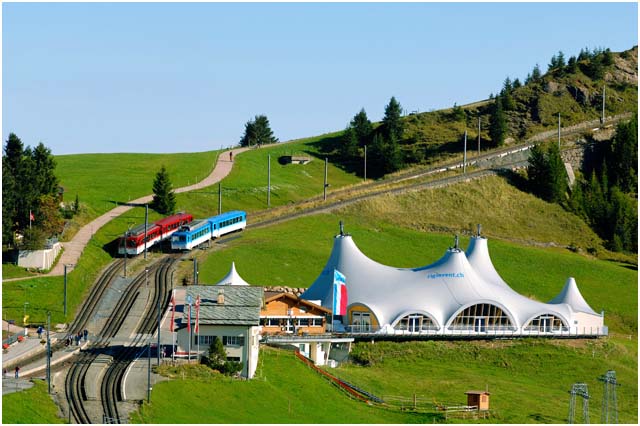
On a clear day... Staffel at 1,604 metres (5,262 feet) looks like this. The red train is running on the Vitznau line while the blue train is on the Goldau line. The summit at Rigi Kulm lies up the grade to the right - Date unknown Rigi Bahnen AG.
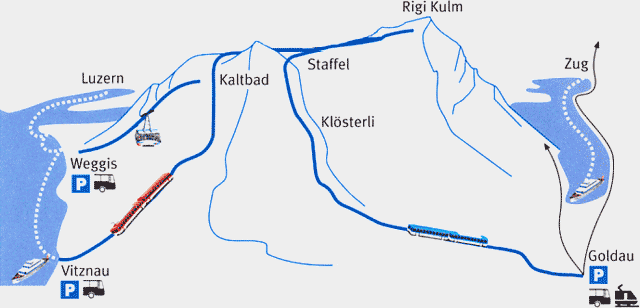  A Brief History A Brief History
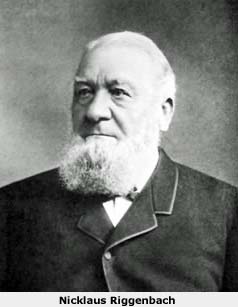 The Riggenbach rack system was patented by Niklaus Riggenbach in France in 1863 working at about the same time as, but independently of, Sylvester Marsh in America. Riggenbach was granted a French patent in 1863 based on a working model which he used to interest potential Swiss backers. During this time, the Swiss Consul to the United States visited Marsh's Mount Washington Cog Railway in New Hampshire and reported back with enthusiasm to the Swiss government. Meanwhile in America, the Mount Washington Cog Railway ran its first train reaching the summit in 1869. Eager to boost tourism in Switzerland, the government commissioned Riggenbach to build a rack railway up Rigi Mountain. The Riggenbach system is similar in design to the Marsh system. It uses a ladder rack, formed of steel plates or channels connected by round or square rods at regular intervals. The Riggenbach system suffers from the problem that its fixed ladder rack is more complex and expensive to build than other systems. The Riggenbach rack system was patented by Niklaus Riggenbach in France in 1863 working at about the same time as, but independently of, Sylvester Marsh in America. Riggenbach was granted a French patent in 1863 based on a working model which he used to interest potential Swiss backers. During this time, the Swiss Consul to the United States visited Marsh's Mount Washington Cog Railway in New Hampshire and reported back with enthusiasm to the Swiss government. Meanwhile in America, the Mount Washington Cog Railway ran its first train reaching the summit in 1869. Eager to boost tourism in Switzerland, the government commissioned Riggenbach to build a rack railway up Rigi Mountain. The Riggenbach system is similar in design to the Marsh system. It uses a ladder rack, formed of steel plates or channels connected by round or square rods at regular intervals. The Riggenbach system suffers from the problem that its fixed ladder rack is more complex and expensive to build than other systems.
The Vitznau-Rigi Bahn
Following the construction of a prototype locomotive and test track in a quarry near Berne, the Vitznau-Rigi Bahn opened on 21 May 1871. On opening day Riggenbach himself led the procession up Rigi's heights to the then terminus of Staffel. The railway system, the buildings, and rolling stock had cost CHF 1,250,000 (CHF = Swiss Francs). It was anticipated that each year 50,000 passengers would use the Vitznau-Rigi Bahn. The reality, however, exceeded expectations. In the first year of operation, over 60,000 visitors took the cog railway and by 1874 numbers exceeded 100,000. When the Arth-Rigi Bahn opened that number then sank for a few years but by 1886 passengers traffic had increased to 102,021.
The Arth-Rigi Bahn
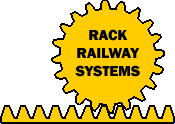 The engineers Riggenbach and Zschokke also built the rack railway Arth-Rigi Bahn. In 1870 a committee of twelve citizens from Arth obtained a Swiss cantonal concession for the lines between Season and Kulm, and between Arth, Oberarth, and Kulm. The construction of the panoramic route between Staffel and Rigi Kulm was tackled by the Arth Company immediately. This company carried out the railway construction as general contractor for CHF 4.2 million, and also supplied five of the six steam locomotives. Operation of the Arth-Rigi Bahn between Arth and Oberarth and Oberarth to Rigi Kulm began in 1875. The open passenger cars were considered very luxurious in that they were equipped with curtains on both sides which protected the passengers from the sun, rain, and wind. In 1907 the route between Goldau and Rigi Kulm was electrified. This conversion was a true pioneer effort making the Arth-Rigi Bahn the first standard gauge rack railway in the world to be electrified. In 1959 the Arth to Goldau railway route was discontinued and replaced with bus operation. The engineers Riggenbach and Zschokke also built the rack railway Arth-Rigi Bahn. In 1870 a committee of twelve citizens from Arth obtained a Swiss cantonal concession for the lines between Season and Kulm, and between Arth, Oberarth, and Kulm. The construction of the panoramic route between Staffel and Rigi Kulm was tackled by the Arth Company immediately. This company carried out the railway construction as general contractor for CHF 4.2 million, and also supplied five of the six steam locomotives. Operation of the Arth-Rigi Bahn between Arth and Oberarth and Oberarth to Rigi Kulm began in 1875. The open passenger cars were considered very luxurious in that they were equipped with curtains on both sides which protected the passengers from the sun, rain, and wind. In 1907 the route between Goldau and Rigi Kulm was electrified. This conversion was a true pioneer effort making the Arth-Rigi Bahn the first standard gauge rack railway in the world to be electrified. In 1959 the Arth to Goldau railway route was discontinued and replaced with bus operation.
Rigi Bahnen
The Arth-Rigi Bahn, the Vitznau-Rigi Bahn, and the Luftseilbahn from Weggis to Kaltbad cable car were fused into one group known as the Rigi Bahnen in 1992.
In 1999 the Rigi Bahnen invented a new rack switch with a pending worldwide patent. The Rigi Event Tent, seen in the photo above, and located in Staffel at an elevation of 1,600 metres was opened in 2007. Steam locomotive number 7 with its vertical boiler was brought out of retirement and transported to Vitznau by road. On 21 May 2009 it ran with renovated carriage number 5 out of Vitznau. Finally, on 7 Sep 2010, construction of the new station for Goldau was commenced.
 Flexible Rack Railway Turnout RIGI-VTW 2000 Flexible Rack Railway Turnout RIGI-VTW 2000
Why a new turnout?
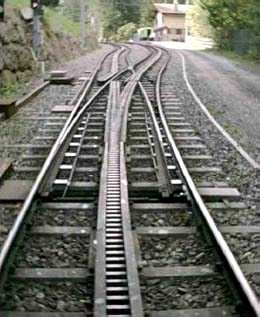 Rack railway system operations and engineering are particularly cost intensive. For a number of years the Rigi Bahnen have been looking actively for new solutions to reduce these costs. They have conducted a number of system studies to investigate, among other areas, the rack technology. After all the rack railway system was developed more than two centuries ago and has been running for 129 years without major changes. The genius of Niklaus Riggenbach was unequaled. The long survival of rack railways is no coincidence. Despite this, engineers of today have to properly question the validity of existing systems. New ideas for introducing suitable production systems are required. Within the Rigi Bahnen, and many other mountain railways, turnouts with racks and switchblades with sliding sections are in use. Rack railway system operations and engineering are particularly cost intensive. For a number of years the Rigi Bahnen have been looking actively for new solutions to reduce these costs. They have conducted a number of system studies to investigate, among other areas, the rack technology. After all the rack railway system was developed more than two centuries ago and has been running for 129 years without major changes. The genius of Niklaus Riggenbach was unequaled. The long survival of rack railways is no coincidence. Despite this, engineers of today have to properly question the validity of existing systems. New ideas for introducing suitable production systems are required. Within the Rigi Bahnen, and many other mountain railways, turnouts with racks and switchblades with sliding sections are in use.
In a search for system improvements the idea for "flexible spring point" was developed in 1988. The idea alone was insufficient so the Rigi Bahnen looked for suitable partners who would be prepared to convert the idea into action. Two partners, Verkehrs und Industrietechnik AG of Switzerland, and Windhoff GmbH of Germany, together with the Rigi Bahnen were prepared to develop a new flexible spring point. The resulting system has been patented world wide.
The project obtained scientific support from the Swiss Federal Institute of Technology in Zurich and the Institute for Transport Planning. After a 10 year maturing process the RIGI-VTW turnout (Rigi-Bahnen, VT Verkehrs und Industrietechnik AG, Windhoff GmbH) was complete.
The turnout construction was required to meet the following specifications:
· More cost effective to purchase;
· More cost effective in operation and maintenance (minimal lubrication more ecological);
· Simple transparent construction;
· Few moving parts and joints therefore less wear and tear;
· No speed restrictions across the turnout;
· Mostly mechanical snow clearing;
· None or minimal heating requirements in Winter;
· A single rack;
· Historical vehicles with parts protruding below the running face of the rail can freely use the turnout;
· Only one single point of instability with a high degree of travel comfort and reduced wear on vehicles;
· High system accuracy in the area of the single rack connection point;
· Execution without a frog eliminating a further point of instability and risk of derailment;
· Allow connection of more than two tracks.
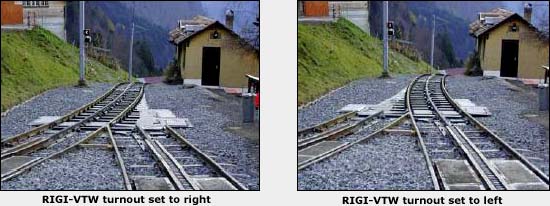
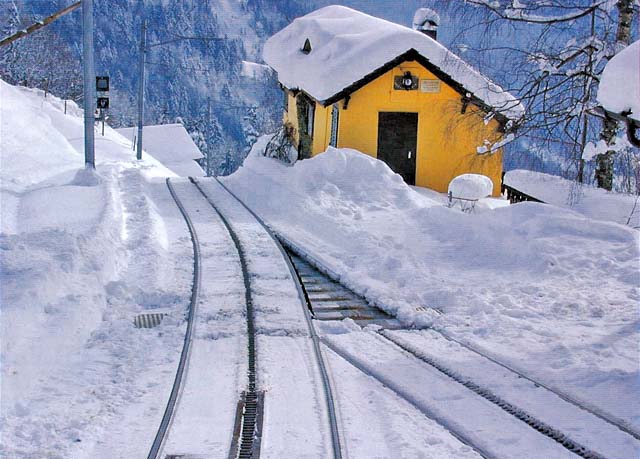
How does the new turnout work?
The spring point is based on the idea of a "cut" track, which as a "spring" fixed in one point is bent along a predetermined curve from one end position to the other. In the end positions the system can be considered a "closed" track. The movable track bed is protected from lifting and kinking with special construction elements. The advantages as compared to the standard turnout with switchblade and sliding elements are obvious. A single sided fixed movable frame (rails + rack + gauge fixation) slides on an upper frame. In the end positions the turnout is locked and supervised. Watch the video.
 New Goldau Bahnhof New Goldau Bahnhof
 On 10 Oct 2010 the last Rigi Bahnen train arrived at the high platform in Goldau. The tracks were then removed after seeing more than 113 years of use.
Construction of the new Goldau station incorporates parts of the old. The high platform is being expanded, totally renovated, and raised 70 centimetres higher. The newly designed high platform will contain an area for ticket sales, a small shop, a waiting area and the interfaces to the SBB Arth-Goldau train station (stair and elevator tower). The raising of the platforms by 70 centimetres may require an adjustment of the historical architectural stair tower on the north side of the high platform. To accomplish this the tower will be slightly raised with a new meeting room added to the attic. In addition, a new passenger elevator and toilet facilities will be installed in the tower.
Until this rebuilding the old station could handle only three trains in a row on one track. The new platform contains two parallel tracks and associated platforms with corresponding Perron roofs. The crossing of incoming and outgoing trains was previously possible only with great difficulty over the depot trackage. The new trackage facility will contain two new Rigi-flex-rack turnouts, the latest technology, creating a significant performance improvement.
Outside normal operating hours the railway station facilities will be closed. During regular operating hours the bridge system provides a link for pedestrians between the two parts of the villages Goldau Hinterdorf and Oberndorf.
 Goldau Bahnhof Re-construction Photos Goldau Bahnhof Re-construction Photos
The Rigi Bahnen web site contains many photographs showing the construction progress of the new Goldau high platform and adds more as time goes by. Below are only eight from the many on their web site:

24 Sep 2010 - The so-called Talgleis, built in 1882 to connect the former Goldau station to the Arth-Rigi Bahn, is dismantled.
| 
10 Oct 2010 - After 113 years of operation the last train pulled by ARB No. 6 arrives on the high platform at Goldau.
| 
18 Oct 2010 - The single track on the old high platform has been removed by this date.
| 
11 Nov 2010 - The old steel bridge over the Rigistrasse connecting the high platform is removed.
| 
5 Jul 2011 - Testing of a newly constructed RIGI-VTW 2000 turnout is carried out before installation.
| 
3 Aug 2011 - This overall view of the construction shows the size of the new concrete two track high platform.
| 
18 Oct 2011 - The new concrete retaining wall along the Rigistrasse is complete and the road is open to traffic.
| 
24 Nov 2011 - The new concrete high platform is nearly complete with the addition of railings.
|
 News Articles News Articles
9 Jun 2008 - Swiss Silver Commemorative Coin "Vitznau-Rigi Railway" Starts New Series
25 Sep 2010 - On the Trail of Mark Twain in Lucerne
 Associated Web Sites Associated Web Sites
Rigi Bahnen
Railfan Europe Rigi Bahnen
Verkehrs und Industrietechnik AG
Windhoff GmbH
Swiss Federal Railways (SBB CFF FFS)
Vierwaldstättersee
Rigi Kulm Hotel
|